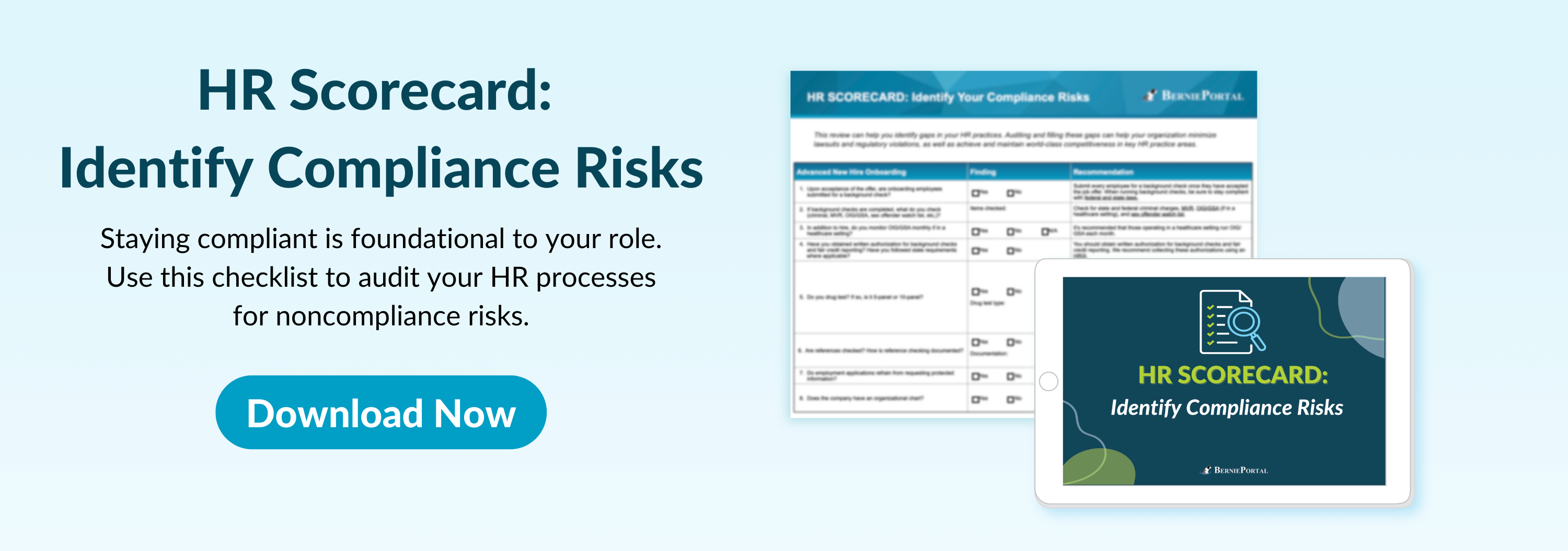
Written by
Aidan Farrish
Aidan is an aPHR-certified writer on the marketing team at BerniePortal. She writes about HR, healthcare, and benefits.
How to Fill Out the EEO-1 Form

The Equal Employment Opportunity Commission (EEOC) deadline for filing 2022 data is December 5, 2023. The platform to submit EEO-1 Forms opens on October 31, 2023.
Here's what employers need to know about this HR compliance form, including how to fill it out and how to file it.
What Is the EEO-1 Form?
According to the EEOC, the EEO-1 survey--or the EEO-1 Component 1 report--“is a mandatory annual data collection that requires all private-sector employers with 100 or more employees, and federal contractors with 50 or more employees meeting certain criteria, to submit demographic workforce data, including data by race/ethnicity, sex, and job categories.” This data is kept confidential.
The EEOC is an organization responsible for enforcing federal laws that make it illegal to discriminate against a job applicant for a variety of factors. For example, this includes a person’s race, color, religion, sex, national origin, age (40 or older), disability, or genetic information. Furthermore, the EEOC has the authority to regulate and investigate most employers with at least 15 employees.
The EEOC investigates charges of discrimination and focuses on settling them when discrimination is found. If parties can’t reach an agreement, the EEOC may file lawsuits on behalf of the individual or the general public. In addition to investigating complaints and handling discrimination charges, the EEOC conducts outreach programs to prevent future cases.
Noncompliance with EEO-1 filing could result in court orders compelling the completion and submission of EEO-1 reports. Penalties include federal contractors and subcontractors losing current and future contracts for federal projects.
What If an Employer Doesn't File an EEO-1 Report?
While compliance is top-of-mind for many HR professionals, noncompliance with EEO-1 reporting does not invite financial penalties. So if your business is required to complete EEO-1 reporting each year, keep in mind that the enforcement agency for EEO-1 reporting is unlikely to levy fines or prompt an audit if you miss a report.
The EEOC may note failure to file EEO-1 reports if your business is a federal contractor or subcontractor. If your business seeks federal contracts, the Office of Federal Contract Compliance Programs (OFCCP) may notify your organization of an impending Notice of Desk Audit, which will request copies of the most recent EEO-1 reports.
Noncompliance with EEO-1 filing could result in court orders compelling the completion and submission of EEO-1 reports. Penalties include federal contractors and subcontractors losing current and future contracts for federal projects.
If your organization is not concerned with these penalties, then EEO-1 noncompliance may be a lesser concern compared to other compliance matters.
Step-by-Step: How to Fill out the EEO-1 Form
To get started, employers can use the EEOC's secure online filing system.
Page 1 is divided into three different sections:
- Section A: In Section A, you’ll indicate the type of report that you’re filing--either for a single establishment or for a multi-establishment employer. For EEO-1 reporting, a multi-establishment employer is any organization that operates at multiple physical locations. If this applies to your organization, you’ll also need to indicate the total number of reports being filed. In other words, this means you’ll have to fill out a report for each location, similar to the OSHA Form 300.
- Section B: In Section B, you’ll report basic information about your company, including the name, address, location, and employer identification number (EIN). You’ll also indicate if your organization filed an EEO-1 report in the previous year.
- Section C: This section will help you indicate if your company is required to actually file the EEO-1 report. You’ll answer three Yes or No questions; if at least one of your responses is Yes, then you should fill out the rest of the form.
This is the easy part. Once you move on to page 2, things get a little more complicated. This page is divided into four sections:
- Section D: In Section D, you’ll report employment data. This is the bulk of the info that the EEOC wants from employers. The reporting chart is split into a few different components: Job Categories, Number of Employees by Race/Ethnicity, and Total Combined Employees per category, per Race/Ethnicity. You should report all permanent full-time and part-time employees as well as apprentices and on-the-job trainees unless otherwise noted. Employers will need the employees’ demographic information, which should be self-reported by the employees. This can be collected during onboarding or using an anonymous survey of employees in order to self-identify their race and ethnicity.
- Section E: In Section E, you’ll report a basic description of your organization’s primary business function and activities. For example, if you run a women’s fashion boutique, you’d list your primary business function as a retail clothing store.
- Section F: This section gives you an opportunity to explain any major changes in reporting from the previous year. For example, if you had to lay off a significant number of employees in 2022, you’d report this in Section F.
- Section G: In this final section, you’ll basically just certify that everything you reported in the form is true and accurate. Then, you’ll sign it and provide a bit more information about yourself for verification purposes.
EEO-1 Reporting FAQs
1. When is the EEO-1 due?
The form submission opens October 31, 2023, and employers have until Tuesday, December 5, 2023, to submit data for 2022.
2. Where can employers go to file the EEO-1 form?
Eligible employers can file the EEO-1 Form through the online portal.
3. Where can I find a sample of the EEO-1 form?
Here's a sample of the EEO-1 form.
4. Who is required to fill out the EEO-1 form?
According to the EEOC, companies must file an annual EEO-1 report:- if it is subject to Title VII of the Civil Rights Act of 1964 and employs 100 or more people
- if it is subject to Title VII of the Civil Rights Act of 1964 and employs fewer than 100 people, but is owned by or corporately affiliated with another company so that the entire enterprise employs 100 or more employees
- if it is a contractor for the federal government, or a first-tier subcontractor subject to Executive Order 11246, employs 50 or more employees, and operates with a prime contract or first-tier subcontract equivalent to or higher than $50,000
5. What information do employers need to fill out the EEO-1 Form?
- Number of full and part-time employees during the specified workforce snapshot pay period selected by the employer
- All employees’ sex and race/ethnicity
- Job categories of all employees, which can be classified using this resource
- Employer Identification Number (EIN)
- DUNS, if a federal contractor
6. Where do I find/collect the information I need to fill out the form?
Employers will need the employees’ demographic information, which should be self-reported by the employees. Employers should send a survey to employees in order to self-identify their race and ethnicity. Additionally, employers will need pay data, which can be found in the employees’ W-2 and hours worked. This is where a human resources information system (HRIS) like BerniePortal comes in handy, as the payroll feature records all of this information and enables HR professionals to send surveys to collect data if necessary.
7. How do employers gather race and ethnicity information from employees?
According to the EEOC, the preferred method of gathering ethnicity information from employees is through employee self-identification. According to the EEOC’s website, employers should do this by offering employees the opportunity to self-identify and providing a statement about the voluntary nature of this inquiry for employees.
8. What if I’m filling out the form for the first time?
First-time filers of the EEO-1 form will need first to register here.
9. What type of EEO-1 Form should I fill out?
If you are a single-establishment company, then you must fill out the Single-Establishment Employer Report.
For employers with multiple establishments, there are other considerations, such as:
-
The Consolidated Report, which includes all of your company's employees categorized by race/ethnicity, sex, and job category.
-
The Headquarters Report, which includes those working at your company's HQ, including those working from home.
-
The Establishment-Level Report(s), which is a separate report needed for each non-HQ establishment.
10. Where can I go if I have more questions?
Employers are encouraged to visit the EEOC’s EEO-1 form website.
Additional Resources
You can stay informed, educated, and up-to-date with important HR topics using BerniePortal’s comprehensive resources:
- BerniePortal Blog—a one-stop-shop for HR industry news
- HR Glossary—featuring the most common HR terms, acronyms, and compliance
- HR Guides—essential pillars, covering an extensive list of comprehensive HR topics
- BernieU—free online HR courses, approved for SHRM and HRCI recertification credit
- HR Party of One—our popular YouTube series and podcast, covering emerging HR trends and enduring HR topics

Written by
Aidan Farrish
Aidan is an aPHR-certified writer on the marketing team at BerniePortal. She writes about HR, healthcare, and benefits.
Related Posts
Part-time work is becoming increasingly common in today’s workforce—especially for...
As you know, healthcare and benefits can be complicated, which can make the enrollment...
With the deadline for filing and distributing 1095-C forms approaching, staying...
A strong paid time off (PTO) policy helps retain current talent and attract prospective...








Submit a Comment